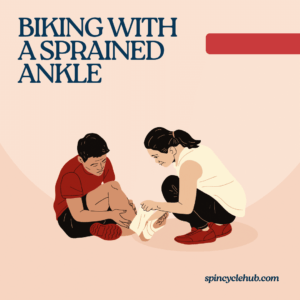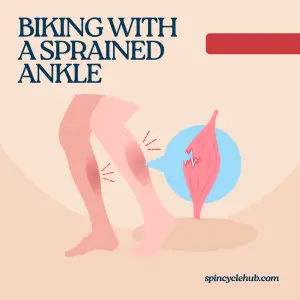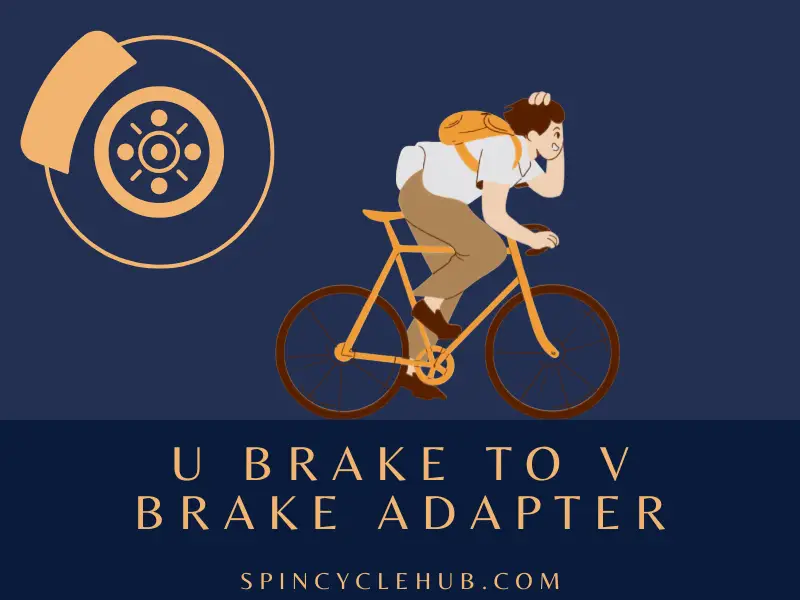Introduction
Getting back on your bike after a sprained ankle can be a daunting prospect. The fear of reinjury and the concern for your ankle’s well-being may make you hesitant to ride. However, with the right precautions and a gradual approach, you can safely enjoy biking while recovering from a sprained ankle. In this article, we will explore the necessary steps to take, the challenges you may face, and how to support your ankle’s healing process.
Understanding the Sprained Ankle
What is a Sprained Ankle?
A sprained ankle occurs when the ligaments surrounding the ankle joint are stretched or torn. It is a common injury among bikers and often results from twisting the ankle during a fall or sudden movement. The severity of a sprain can range from mild to severe, with symptoms including pain, swelling, and difficulty walking.

Common Causes of Sprained Ankles
Sprained ankles can happen in various biking scenarios, such as misjudging a jump, landing awkwardly, or even losing balance during a challenging trail. Understanding the causes can help you take precautions and avoid potential risks in the future.
How Does a Sprained Ankle Affect Biking?
Biking with a sprained ankle can be challenging due to the strain placed on the affected joint. The pedaling motion and the uneven terrain can exacerbate pain and hinder the healing process. However, with proper care and techniques, it is possible to continue biking while minimizing discomfort and promoting recovery.
Assessing the Feasibility of Biking with a Sprained Ankle
Seek Medical Advice
Before resuming biking, it is essential to consult with a medical professional. They will evaluate the severity of your sprain, provide specific recommendations, and advise on the appropriate timing for returning to physical activities.
Evaluate the Severity of the Sprain
The severity of a sprained ankle can vary, ranging from grade 1 (mild) to grade 3 (severe). Your doctor will assess the extent of the injury, which will guide your recovery plan and determine when it is safe to start biking again.
Consider Pain Tolerance and Individual Factors
While medical advice is crucial, it is essential to consider your personal pain tolerance and individual factors. Everyone’s healing process is unique, and what may work for one person may not be suitable for another. Be mindful of your body’s signals and proceed accordingly.
Preparing for Biking with a Sprained Ankle
R.I.C.E Therapy: Rest, Ice, Compression, and Elevation
Initially, focus on rest and allow your ankle to recover. Apply ice packs to reduce swelling, use compression wraps or braces for support, and elevate your leg whenever possible. This regimen, known as R.I.C.E therapy, aids in the early stages of healing.
Supporting the Ankle with Braces or Wraps
To provide stability and prevent further injury, consider using ankle braces or wraps specifically designed for biking. These support structures can minimize excessive movement and protect your ankle while riding.
Gentle Ankle Exercises and Physical Therapy
As your ankle heals, incorporate gentle ankle exercises recommended by your doctor or physical therapist. These exercises will help improve mobility, strengthen the surrounding muscles, and enhance stability.
Choosing the Right Bike and Equipment
Opt for a Comfortable and Stable Bike
Choosing the right bike is crucial when biking with a sprained ankle. Opt for a comfortable and stable bike, such as a mountain bike or a cruiser, that allows for better balance and control.
Modify Your Bike Setup
Make adjustments to your bike setup to accommodate your sprained ankle. This may include raising the seat height to reduce strain on the ankle or adjusting the pedal position for a more comfortable riding experience.
Protective Gear for Your Ankles
Investing in protective gear, such as ankle braces or specialized biking shoes with ankle support, can provide added stability and protection. These gears are designed to minimize the risk of reinjury and offer peace of mind while riding.
Techniques and Strategies for Biking with a Sprained Ankle
Gradually Ease into Biking
Start with short and gentle rides to allow your ankle to adapt gradually. Begin on flat surfaces or bike paths, gradually increasing the duration and intensity as your ankle strengthens.
Focus on Low-Impact Terrain and Routes
Avoid rough and technical terrains that may put excessive stress on your ankle. Instead, opt for smoother surfaces with minimal obstacles to reduce the risk of reinjury.
Maintain a Relaxed Riding Style
Keep a relaxed riding style and avoid unnecessary strain on your ankle. Pedal at a comfortable pace and distribute your weight evenly on both pedals to minimize pressure on the affected ankle.
Avoid High-Risk Activities and Stunts
While recovering from a sprained ankle, it is essential to avoid high-risk biking activities, such as jumps, drops, or aggressive maneuvers. Stay within your comfort zone and gradually reintroduce challenging maneuvers once your ankle has fully healed.
Dealing with Challenges and Managing Pain
Listen to Your Body
Pay attention to any discomfort orpain signals your body sends while biking. If you experience increased pain or swelling, it’s crucial to listen to your body and take a break. Pushing through the pain can lead to further injury and delay your recovery.
Adjusting Bike Techniques and Posture
Experiment with different bike techniques and posture adjustments to find what works best for your sprained ankle. This may include slightly changing your foot position on the pedals or modifying your riding posture to alleviate pressure on the affected ankle.
Managing Pain and Discomfort
If you experience pain or discomfort during or after biking, apply ice packs or take over-the-counter pain medication as directed by your healthcare provider. Additionally, utilizing topical pain-relieving creams or gels can provide temporary relief.
Alternate Between Biking and Rest
To prevent overexertion and aid in the healing process, alternate biking sessions with rest days. This allows your ankle time to recover and reduces the risk of aggravating the sprain.
Supporting Recovery and Healing
Follow the Rehabilitation Plan
Adhere to the rehabilitation plan prescribed by your healthcare provider or physical therapist. This may include specific exercises, stretches, or therapies designed to improve ankle strength, flexibility, and range of motion.
Incorporate Strength and Balance Exercises
To support your ankle’s recovery, incorporate strength and balance exercises into your routine. Exercises like calf raises, ankle circles, and single-leg balances can help rebuild strength and stability in the ankle joint.
Stay Consistent with Rest and Recovery
Rest and recovery are crucial components of the healing process. Ensure you get adequate sleep, prioritize rest days, and avoid overexertion to give your ankle the time it needs to heal effectively.
Patience and Persistence are Key
Recovering from a sprained ankle takes time and patience. It’s important to remember that each person’s healing process is different. Stay positive, be persistent with your rehabilitation plan, and trust that your ankle will gradually regain its strength.
Tips for Preventing Future Ankle Injuries
Strengthening Ankles through Exercise
Engaging in regular ankle-strengthening exercises can help prevent future ankle injuries. Include exercises like ankle rotations, resistance band exercises, and balance training in your workout routine to build strong ankle muscles.
Proper Warm-up and Stretching Routine
Before each biking session, perform a thorough warm-up routine that includes dynamic stretches for your ankles, calves, and lower body. Warming up prepares your muscles and joints for physical activity and reduces the risk of sprains and strains.
Wearing Supportive Shoes and Orthotics
Invest in supportive biking shoes that provide stability and ankle support. Additionally, consider using orthotic inserts or custom insoles to improve foot and ankle alignment, reducing the risk of injury.
Being Mindful of Your Surroundings
Pay attention to your biking environment to avoid potential hazards that could lead to ankle injuries. Watch out for uneven surfaces, rocks, roots, and other obstacles that may increase the risk of a sprain.

Conclusion
Biking with a sprained ankle is possible with proper care, preparation, and patience. By following the guidelines provided in this article and listening to your body, you can continue enjoying the thrill of biking while allowing your ankle to heal. Remember, safety should always be a priority, so consult with a healthcare professional if you have any concerns or questions.
FAQs (Frequently Asked Questions)
Q1: Can I ride a bike immediately after spraining my ankle?
A1: It is generally not recommended to ride a bike immediately after spraining your ankle. You should seek medical advice to assess the severity of the sprain and determine when it is safe to resume biking.
Q2: Is it necessary to see a doctor for a sprained ankle before biking?
A2: Yes, it is advisable to see a doctor for a proper diagnosis and treatment plan. They can evaluate the extent of the sprain, provide appropriate guidance, and ensure there are no underlying injuries that may worsen with biking.
Q3: Can I still participate in competitive biking with a sprained ankle?
A3: Competing in biking events with a sprained ankle is not recommended. The intense nature of competitive biking may put excessive strain on your ankle and increase the risk of further injury. Consult with a medical professional for specific guidance based on your condition.
Q4: How long does it take to fully recover from a sprained ankle?
A4: The recovery time for a sprained ankle can vary depending on the severity of the sprain. Mild sprains may take a few weeks to heal, while severe sprains can take several months. It is essential to follow your doctor’s instructions and be patient with the healing process.
Q5: Should I avoid biking altogether if I have a history of ankle injuries?
A5: If you have a history of ankle injuries, it’s important to take precautions and consult with a healthcare professional before resuming biking. They can provide specific recommendations based on your previous injuries and help minimize the risk of reinjury.
- Recovery Tips for Biking with a Sprained Ankle This article from www.rei.com offers practical tips and advice on recovering from a sprained ankle and returning to biking safely. It covers topics such as rehabilitation exercises, bike modifications, and techniques for managing pain.
- Ankle Sprains: Prevention and Treatment Mayo Clinic provides comprehensive information about ankle sprains, including prevention and treatment strategies. While not specific to biking, the information can be helpful in understanding the injury, its causes, and general recovery guidelines.
Watch this one,
Video Credits – HiFLEX Health & Performance
DOWNLOAD THIS ARTICLE :Click Here
You May Also Like
-
Bike Chain Rubbing Against Front Derailleur: Causes and Solutions
-
Mastering the Watts: A Guide to Boosting Your FTP from 200 to 300



